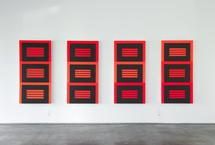Peter Halley’s work began to acquire importance during the 80s’, a decade shaped by an ambiance of intense theorization in the art world and marked by an uncertain political atmosphere in America - a time in which artists had a predilection for the past, for going back to traditional forms. The field of painting experienced the strongest response to such inclinations. This was partly due to the taste that dominated during the previous decade, the 70s’, characterized by a strong fondness in favour of conceptualism and performance art and against the acceptance of the practice of painting.
Previous generations of abstract painters described their rectangular coloured compositions as either representations of universal and harmonic balance - like Mondrian or Malevich; or as evocations of the Supreme, notions beyond human understanding - such as Newman or Rothko.
Halley suggests another way of interpreting geometric abstraction. For the artist, it can be re-interpreted as an analogy of the underlying structures that govern technological societies. In his essays, the artist exposes his case like a re-contextualized abstraction that represents not an escape towards mysticism, but a social and aesthetic critic.
The style of Peter Halley’s work reaffirms Jean Baudrillard’s idea of “simulation” as the principle to follow in late XXth century western culture.
Cells and conducts became recurrent images in Halley’s works, being still presently used. All types of metaphors can be read in his work: from computer chips to rooms or communication lines, which in turn, transform the hard edges of colour paint into cliffs to separate the different colours.
The cell typically has the granular texture of the false stucco, of which Halley claims to be reminiscent of “motel ceilings.”
